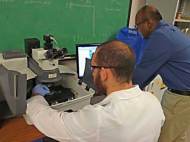New self-healing coating for aluminum developed to replace chromates
 Attempts to replace chromate coatings with non-toxic coatings have been underway since the 1980s. The awareness on effects of chromates was brought to the forefront in 1993 by the real-life incident involving Erin Brokovich and depicted in the movie released in 2000 of the same name. A research team at the University of Nevada, Reno has developed a new environmentally-friendly coating for aluminum to replace the carcinogenic chromate coatings still used by defense and aerospace industries.
Attempts to replace chromate coatings with non-toxic coatings have been underway since the 1980s. The awareness on effects of chromates was brought to the forefront in 1993 by the real-life incident involving Erin Brokovich and depicted in the movie released in 2000 of the same name. A research team at the University of Nevada, Reno has developed a new environmentally-friendly coating for aluminum to replace the carcinogenic chromate coatings still used by defense and aerospace industries.
Although the use of chromates for consumer and automotive applications has been banned, it is still in use by the defense and aerospace industries under various exemptions. The carcinogenic coatings were exempted from the ban due to unavailability of suitable replacement combined with the high human and financial cost of failure from corrosion, as well as its ability to self-heal once it has been damaged or scratched.
The University of Nevada, Reno team developed and tested more than 300 coatings before finding a suitable alternative. They used a complimentary suite of advanced surface analytical techniques such as Raman microspectroscopy, Fourier transform infrared spectroscopy, energy dispersive spectroscopy, secondary ion mass spectroscopy and X-ray photoelectron spectroscopy to conclusively prove the presence of self-healing ability.
“This has taken 14 years of work, continuing on work I did at the State University of New York at Stony Brook and the Brookhaven National Laboratory”, said Dev Chidambaram, lead scientist and assistant professor of materials science and engineering at the University of Nevada.
The new formula creates an environmentally-benign molybdate-based coating that provides corrosion protection to aluminum, used for aircraft and spacecraft. Tests confirmed that the formulation performs comparably to the chromate formula in its ability for self-healing and it can be applied to all aluminum products.
The team includes graduate student David Rodriquez, who conducted the extensive testing on the materials, and undergraduate aerospace engineering major at the University of Colorado, Boulder intern Roshan Misra, who began the project as a high school summer intern from Reno High School. The team is still working to optimize the coating formulation for even better protection.
For more information, visit the Chidambaram’s website electrochemical.org.









Leave your response!